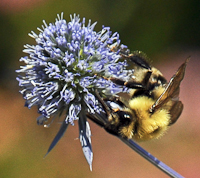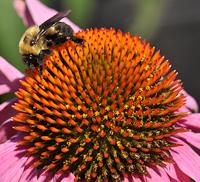|
 |
|
 |
|
 |
 |
 Odds are that the big
(¾ to 1 inch long) yellow to orange and black bee
buzzing around your garden is probably a species of
bumblebee. They are a relative of
honeybees and are
also excellent pollinators. They nest in the ground
in abandoned chipmunk or other rodent tunnels. A
large colony of bumblebees produces a couple hundred
individuals. In the fall, all the bumblebees in the
nest die except for a few females who overwinter and
go to make new nests in the following spring. Odds are that the big
(¾ to 1 inch long) yellow to orange and black bee
buzzing around your garden is probably a species of
bumblebee. They are a relative of
honeybees and are
also excellent pollinators. They nest in the ground
in abandoned chipmunk or other rodent tunnels. A
large colony of bumblebees produces a couple hundred
individuals. In the fall, all the bumblebees in the
nest die except for a few females who overwinter and
go to make new nests in the following spring.
Their niche in the pollinator community of insects
is defined by the fact that they have a longer
tongue than honeybees. They can reach down
into flowers to get the nectar that their cousins
cannot gather.
|
 |
 |
 Bumblebees, just like
honeybees, should not be killed if at all possible.
About the only reason to kill a colony is if they build
a nest in an area frequented by children or people who
have a bee allergy. Fortunately, bumblebees are not
aggressive and will only sting if they or their nest are
in danger. Bumblebees, just like
honeybees, should not be killed if at all possible.
About the only reason to kill a colony is if they build
a nest in an area frequented by children or people who
have a bee allergy. Fortunately, bumblebees are not
aggressive and will only sting if they or their nest are
in danger.
|
|
 |
|
Note: We
have provided some general information and
observations on this topic aimed at the home
gardener. Before you take
any serious action in your landscape, check
with your state's land grant university's
Cooperative
Extension
Service for the most current,
appropriate, localized recommendations. |
|
 |
|



